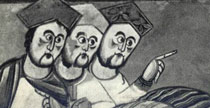 The finger The finger
The raised index finger as a gesture of respect was an Iranian gesture
H. Behzadi
February 21, 2007
iranian.com
Since turning 40 I have become interested in history having never really had any interest in the subject. If anything I am of the generation whose parents considered studying anything other than engineering, sciences or medicine, a mortal sin.
Sometime ago I wrote a piece about the story of the three Magi which is a well known story in Christianity, "The Magi, revisited". Just before Christmas last year there was a well researched programme on British TV about it as well, using astronomical arguments to justify the story of the three Iranian or Persian Zoroastrian priests foretelling the birth of Christ and their journey to see the wunderkind bearing him gifts.
What fascinated me about this story was not lofty Iranian pride (even though I do get accused of being like the Dad in 'My Big Fat Greek Wedding' - who considered the origin of everything to be Greek - by my wife and daughter) but how this idea originated and the reason it was given prominence in Christian texts.
I neither have the resources or the time to research history. It was just by pure dumb luck that I came by a book in my uncle's library in Norway by a French archaeologist called Roman Ghirshman specialising in Iran that provided a logical explanation for the above story or myth perpetuated in Christianity by appearing in the testaments.
The book long out of print was part of a series called the Art of Mankind. There was obviously a series on Iran and the volume that I started leafing through was Parthians and Sassanians. It is without question a most fascinating book. By chance I found a reference in it about the tree Magi and boy was it a revelation.
In a nutshell the story of the three Magi is part of the history of how Christianity became accepted as the state religion of the Roman Empire. It was used to make it respectable and acceptable by the Roman Military who practised Mithraism.
Ghrishman cites various icons of Christianity including this picture of a 12th century stained glass window in Church of Vicq in Central France: 'Journey of the Magi'. In the words of Ghrishman, the early Christians invented the iconographic theme of the 'Adoration of the Magi' to symbolise the triumph of Christ over Mithras. He then goes on to discuss other instances of how Christianity has taken ideas from Mithraism.
There is a movement in the West by the way to disassociate Mithraism from its Persian origins by 'modern' scholars of Mithraism. Others have written about an undercurrent of animosity towards the influence of ancient Iranians on their world by some academics. But if as some of these scholars argue that there is no connection between Mithraism as practised by the Roman Military then why was there a need for Persian Magi as a symbol of the triumph of Christianity over Mithraism.
Ghrishman also makes another point which made me jump. And it is truly fascinating. It has to do with the finger! Look at pictures below, the depicted saints have all raised their index finger in a sign of respect similar to the Magi.
 . . . . . . . .
The raised index finger as a gesture of respect was an Iranian gesture, first appearing on the bas-reliefs in Naqsh-e-Rustam. It appears on the relief showing Ardashir I before Ahuramazda in his investiture (picture below), by the Sassanid noblemen before Shapur I on the Bishapur bas-relief, Bahram II and family (3rd row of pictures below). In every relief you see this as gesture of respect. By the way the person kneeling in front of Shapur in the second row is the Roman Emperor Phillip (please remember that when you get bombarded by western propaganda about the Roman Empire).
In Christian iconography, the 'Finger' later becomes the norm as gesture of respect and was used by the like of Leonardo da Vinci, in his most famous paintings such as the Last Supper (the disciple on the right holding up his index finger), Annunciation of Mary, St. John, the Virgin of the Rocks (there is an argument as to which baby is Jesus and which is St. John the Baptist, if I had my guess, St. John would be the one holding up his fingers in a gesture of respect). In some painting it's one and in others two fingers held up.
As for those who argue against Persian origins of Mithraism, look at the picture of this relief of the investiture of Ardashir II from Taq-e-Bustan, the Shah stands between two gods Ahuramazda on the right who is handing him the diadem, Mitra (Mithras) on the left, recognizable by this rayed headdress holding a barsom and there is a slain Roman at the Shah's feet.
 . . . . . .
I hope the above gives some sense of excitement of discovering the origin of some of the ideas carried through the ages. Comment
|